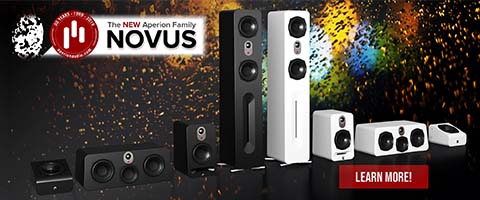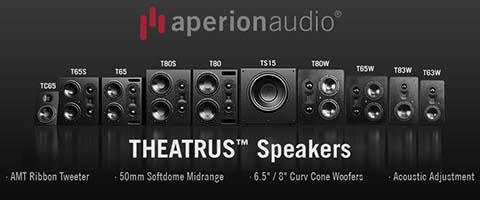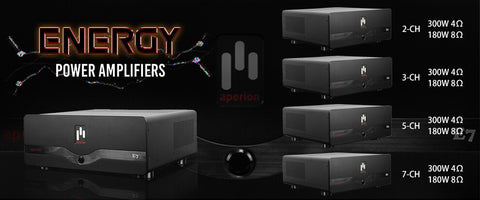 When you're shopping for speakers there's a myriad of criteria that you can use to evaluate the choices: bookshelf vs. tower, cabinet vs. in-wall or in-ceiling and many others. Another one that comes up frequently is passive speaker (s) vs. active speaker (s). Here at Aperion, we make both active and passive, our Daedalus and Bravus subwoofers are active, while our Novus, Verus and Theatrus lines are all passive speakers.
When you're shopping for speakers there's a myriad of criteria that you can use to evaluate the choices: bookshelf vs. tower, cabinet vs. in-wall or in-ceiling and many others. Another one that comes up frequently is passive speaker (s) vs. active speaker (s). Here at Aperion, we make both active and passive, our Daedalus and Bravus subwoofers are active, while our Novus, Verus and Theatrus lines are all passive speakers. - - - - - - - - - - - - - - - - - - - - - - - - - - - - - - - - - - - - - - - - - - - - - - - - - - - - - - - - - - - - - - - -
Hold Up, What are Active and Passive Speaker (s)?
Good question! Let's back up a bit and explain the differences between each type of speaker. In the simplest terms, an active speaker is one that has its own amplifier built into the cabinet. A passive speaker draws its power from an external amplifier and is connected to that amp via speaker wire. Passive speakers tend to be for home use. Active speakers are commonly seen in pro audio for pa systems and monitors but are also used in consumer audio for subwoofers, Bluetooth speakers as well as some other home audio speakers. There are also differences between the crossover configurations of these speakers, more on that later.
- - - - - - - - - - - - - - - - - - - - - - - - - - - - - - - - - - - - - - - - - - - - - - - - - - - - - - - - - - - - - - - -
OK Got It. So, which is better? Passive or Active?
As usual, which speaker will be best for you depends on what you'll be using it for as well as your specific needs. So to answer the question of which is better, we'll have to cop out with a noncommittal, "it depends". Instead of over-simplifying things, let's take an in depth look at the advantages of both passive and active speakers.- - - - - - - - - - - - - - - - - - - - - - - - - - - - - - - - - - - - - - - - - - - - - - - - - - - - - - - - - - - - - - - -
Passive Speaker Benefits
Less Wires/ Easier to Place
Easier to upgrade/replace amp
 solid state to tube or Class A/B to Class D, it's easy, you go out and buy a new amplifier and then hook it up to your new speakers. Boom, upgraded! With an active speaker it's not so easy and in some cases may actually be impossible. Now in terms of upgrading an active speakers amp, that doesn't usually come up because the amp that is included should be the best match for the speaker's specifications. Perhaps you could improve on it, but there's a good chance that the manufacturer included the particular amp because that's what the speaker needed to perform optimally. However, when an amplifier in an active speaker ceases to function, you'll need to replace that amp in order to avoid having a very expensive paperweight or doorstopper. Hopefully the manufacturer has replacement amps on hand and it's not too difficult to replace without damaging the cabinet. Sometimes both are the case, but often times one or the other is not, especially when dealing with a speaker that has a few years on it. If it's a model that has been discontinued for a while, there's a decent chance that parts are no longer available. In that scenario the speaker is probably out of warranty and you're looking at replacing the entire unit. In other cases the manufacturer may have replacement amps but they aren't really easily swapped out and you'll have to send the speaker back for a technician to install the new amp. When that happens, you may be on the hook for shipping costs as well as parts and labor if you are out of warranty and you'll also be without your speaker for however long it takes for shipping and the repair. In short, since a passive speaker doesn't have its own amplifier, there's no complicated electronics that can fail, and you get to choose the amplifier you use to power the speaker.
solid state to tube or Class A/B to Class D, it's easy, you go out and buy a new amplifier and then hook it up to your new speakers. Boom, upgraded! With an active speaker it's not so easy and in some cases may actually be impossible. Now in terms of upgrading an active speakers amp, that doesn't usually come up because the amp that is included should be the best match for the speaker's specifications. Perhaps you could improve on it, but there's a good chance that the manufacturer included the particular amp because that's what the speaker needed to perform optimally. However, when an amplifier in an active speaker ceases to function, you'll need to replace that amp in order to avoid having a very expensive paperweight or doorstopper. Hopefully the manufacturer has replacement amps on hand and it's not too difficult to replace without damaging the cabinet. Sometimes both are the case, but often times one or the other is not, especially when dealing with a speaker that has a few years on it. If it's a model that has been discontinued for a while, there's a decent chance that parts are no longer available. In that scenario the speaker is probably out of warranty and you're looking at replacing the entire unit. In other cases the manufacturer may have replacement amps but they aren't really easily swapped out and you'll have to send the speaker back for a technician to install the new amp. When that happens, you may be on the hook for shipping costs as well as parts and labor if you are out of warranty and you'll also be without your speaker for however long it takes for shipping and the repair. In short, since a passive speaker doesn't have its own amplifier, there's no complicated electronics that can fail, and you get to choose the amplifier you use to power the speaker. They're Usually Lighter Weight
- - - - - - - - - - - - - - - - - - - - - - - - - - - - - - - - - - - - - - - - - - - - - - - - - - - - - - - - - - - - - - - -
Active Speaker Benefits
The Amp and Speaker are Designed to Go Together
The Signal Goes Through the Crossover Before the Amplifier
So that concludes our examination of passive and active speakers. If you are looking for an easy to place speaker and want to be able to choose your own amp or upgrade it, then a passive speaker is probably the way to go. If you want a speaker that can play loud with lots of bass or you want to be able to stream wirelessly to it, then an active speaker will fit the bill. Many people, including almost all home theaters, have both types of speakers integrated into one or several set ups.

Complete Your Sound System Solution

Sign up for our newsletter below, and join our social media groups to stay up to date with the latest news and information from Aperion Audio!
 |
 |









 https://www.aperionaudio.com
https://www.aperionaudio.com